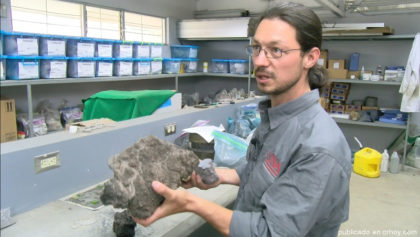
Geoffrey Avard
Opposite us, a dark cookie-shaped stone seems to have nothing exceptional. But it does: it is a piece that set a precedent for Turrialba Volcano .
It is the first lava block material found by scientists in the vicinity of the volcanic crater since it increased its activity in the last 3 years.
The stone remains in the petrology laboratory of the Volcanological and Seismological Observatory of Costa Rica (OVSOCORI), under constant analysis.
According to Geoffroy Avard, a vulcanologist at that center, the bomb – as this material is known – was ejected at more than 900 °C.
The shape that it has is due to the fact that, in a magmatic state, it conformed to the morphology of the site where it fell.
If one compares the ejected lava with other incandescent material emitted long ago, some differences are noticed: the color, the texture and the composition.
Unlike lava, the other blocks of material emitted in other eruptive stages are yellow or gray.
The stage that the Turrialba experienced in November is known as Strombolian. It refers to the Italian volcano Stromboli, which is characterized by explosive eruptions alternating with periods of calm, casting ash, magma and gases .
There is the perception that a volcano only ejects lava in the form of castings, but this is wrong. It can be launched in the form of ash or bombs. Also, not all incandescent material is always lava.
The output of magmatic material of this type is good news. The duct is open, then the gas finds its way out. For this reason, it has less chance of increasing the pressure and decreases the explosive danger,”
said Avard.
However, the internal temperature reported in recent days indicates that the interior of colossus can reach 900 °C, a sign that the magmatic material would be near the crater.